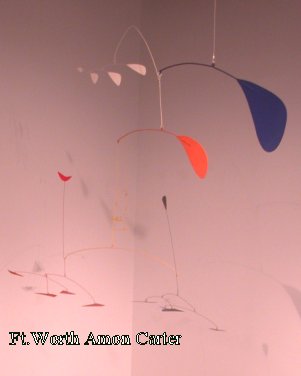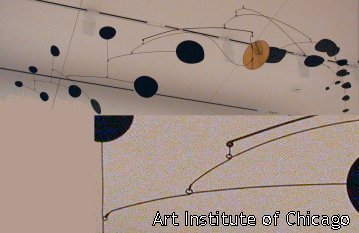|
I grew up with mobiles made by my mother in the late 40's and
early 50's where the items being hung might be seashells, leaves or metal
representations of leaves, or almost anything. These were mounted with
threads on longish rods or thin
branches and each was free to pivot completely around. While at Iowa State
University in the mid - 60's, I built a mobile as a stage set for a synchronized
swimming show (below)
Making a mobile with glass pieces involves dealing with the
weight of the glass. One can make a bold statement with heavier pieces of
wire, use wood shapes, or add a yoke as with the stage piece. Notice the
truss structure of the supports for the Calder clouds unit above, consider how
much heavier it would look if the beam side were filled in. Or one can
intentionally use a light pieces of glass as will produce the effect.
Building a mobile is a matter of arranging the pieces in a
pleasing layout, perhaps on a piece of paper, sketching in the support rods,
then building from the bottom up, making each pair balance then each group
balance against the counter item. With practice, noticing the very heavy
that will balance against several items becomes obvious, but at first it is
likely that a layout will be attempted that can not be made to balance and also
be attractive.
Very light items - origami, real leaves, dried butterflies - have little
momentum - a draft may make them move, but they stop quickly. Heavy items may
not move in a draft at all but will keep moving if touched. One solution
is to put a heavy item on a support close to the balance and a light item way
out - the light item moving in a slight breeze or draft and the momentum of the
heavy part keeping it moving. The weight of the supports may provide
momentum - I have one made of artificial leaves with thin branches for supports
that is pleasing in movement from central heating vents.
Not fitting the usual definition of a mobile, the seashell handing form
at right, strips of light fabric hung like banners to move in drafts, and paper
hangings like the origami cranes on thread at the Crow oriental museum can make
for attractive units.
I use carpet thread most often and use a basic slip knot for fastening so I can
adjust for balance and appearance, coming
back with a touch of glue to fix the location and knot in place. Using
monofilament fishing line will make a less visible line but one that is harder
to knot and less free to twist. Thin wire is even less free to twist and
may be difficult to keep completely straight as it holds its own bends.
With enough size and weight in the items and supports, coarser string or light
rope may make an attractive line, provide necessary visual confidence to
viewers, and flex enough to transmit torque to the other pieces to enhance
overall rotation.
I have found that I like a denser arrangement of pieces in most cases - that is,
I like to have all the pieces forming a closely related visual group that shifts
within the group.
There are two other alternatives. One is a very
sparse arrangement - Calder used, during WWII, 3 or 4 wood shapes a few inches
across that were spaced over several feet, the hanging wires being lines
connecting the pieces.. The other is in between - an arrangement that is
closely related at times but some or all of the elements swing out well away
from the concentrated area - this requires a hanging arrangement of short arms
and long arms so the piece unfolds from the most compact position.
I prefer to hang a mobile from a fishing swivel, some come with ball bearings,
so that it does not always come to rest in the same rotational direction which
tends to happen with a firm hanger connection. Some mobiles, such as
Calder's Clouds above require a motor to provide movement and high quality
bearings to provide rotation below.
The guy who invented the mobile, Calder, as sculpture also
created the stabile, which was supposed to be firmly on the ground. Calder's
stabiles don't move much because most of them are pretty heavy and we aren't
supposed to touch them (the sign says.)
Here are a bunch of pictures (Google
search) many of which show pieces with no moving parts. I like them better
when they do.
Now the Nasher, here in Dallas, has one of each
type and they say the stabiles have no moving parts. (click on
images) which confuses me. And I swear they have a heavier one than the Spider
shown on that page.
If you look at the Spider, you will see that like many of his mobiles, it
consists of wire (or rods) with a loop at the hanging point and fairly rigid
connections (not the strings used on craft mobiles) So the wire and the shapes
make line and form combinations.
To make a moving mobile/stable, you lay out the cutout shapes that will be on
the wires/rods, and then you start from the bottom making a piece with shapes on
each end and finding the balance point. Then you use that whole unit as one end
of the next wire up and put a shape out at the end and balance that (like hold
it with needle nose pliers and loosen the grip and slide the wire till it
balances on one jaw, taking a grip if it starts to tilt too far.
|
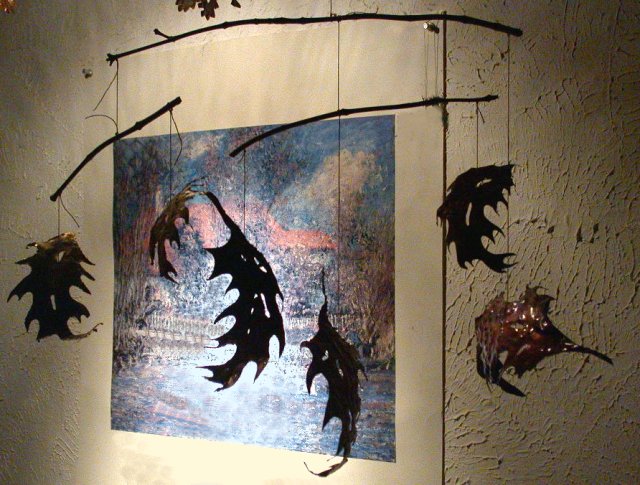
Mobile made of copper leaf shapes hung from slightly carved real branches (click
to enlarge)
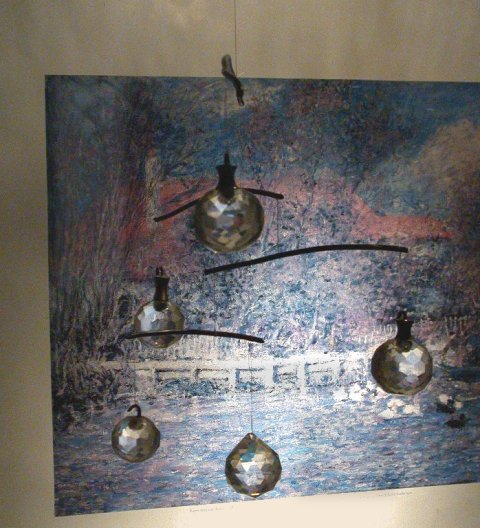
Mobile made of cut crystal spheres from cabinet knobs and other sources
hung by thin thread from slightly bent thick steel wire. The mass of the spheres
makes movement in house drafts unlikely, so placing it to be touched may be
useful. Since moved to a window that gets direct sun along a passage way -
throws small rainbow stripes on walls and floor. 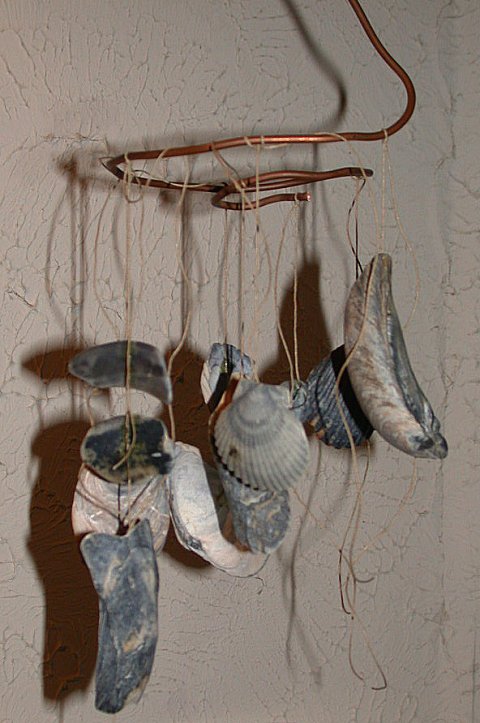
Mobile/chime in progress with carpet thread glued to
seashells hung from a spiral of copper wire, hung close together for sound.
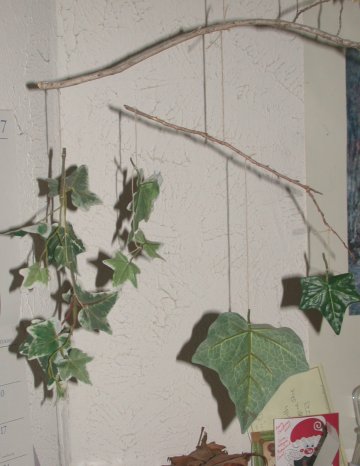
This mobile is made of real branches and selections of leaves from artificial
vines sold at Michaels or Hobby Lobby. Very light so it moves in heating/AC
drafts. Not a lot of effort in making or photographing, obviously.
2009-05-25 |
The images below show the
largest mobile I ever
designed and built, which was done back in 1965. The synchronized
swimming group Naiads, of which I was the only male member for two years,
had performed their annual shows in the women's pool which had limited
seating on one side. ISU built a huge new Natatorium in the area of
the men's gym facilities and snagged the NCAA swimming and diving finals. My
second year, Naiads got to use the large T-shaped pool for their show and I
proposed this design to hang over the diving pool portion farthest from the
audience. Each item is related to some element of the show and include
a guitar, a cupped hand, a mask, a musical note and a G clef each in a
window frame, a mask and the Naiads logo of a female swimmer silhouette on a
narrow hexagon shape..
Each had some kind of frame which served also to protect them during
mounting. Because they were over water, the unit had to be assembled
on the side, lifted clear of the deck on one line then pulled to the center
on the main hanging line while letting out the side lifting line.
Getting access to the ceiling space and getting the pieces in involved
considerable negotiations. When the NCAA came in, they simply took out
a huge window that looked from a hallway for access and clear TV shots.
The thin black and wood color horizontal support bars are 1x2 lumber.
Barely visible in these images is the rope yoke that goes from the ends of
each support to shape the curve and take most of the weight of the pieces;
without the yoke the supports would bend and snap, thus they are actually
pushing the ends of the yoke ropes out. As I recall, each piece
weighed 10-15 pounds - the guitar and hand were hollow paper structures
built on a wire frame. 2010-03-08
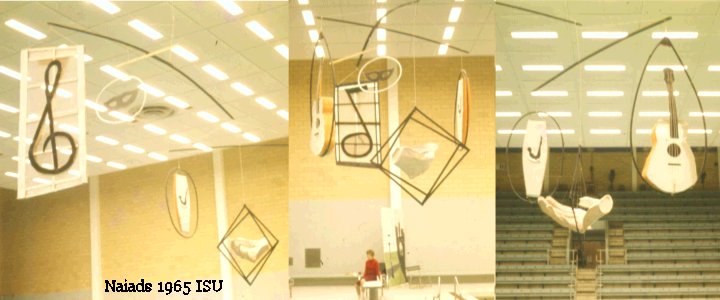 |
